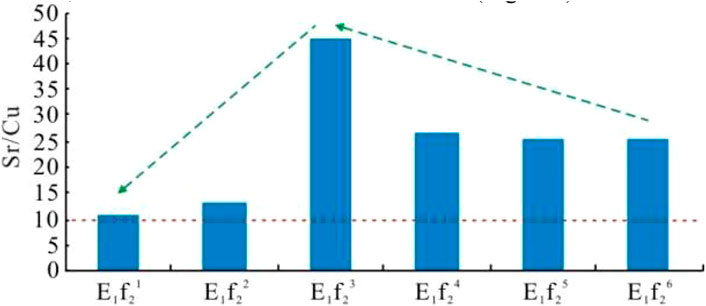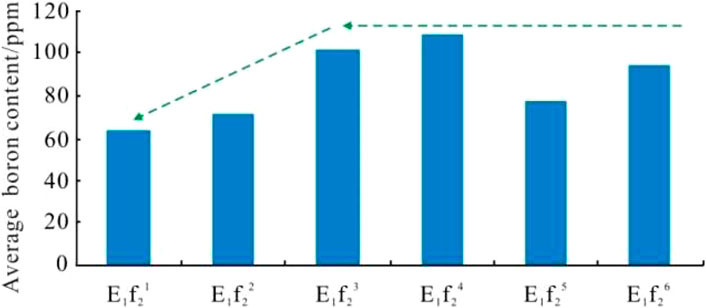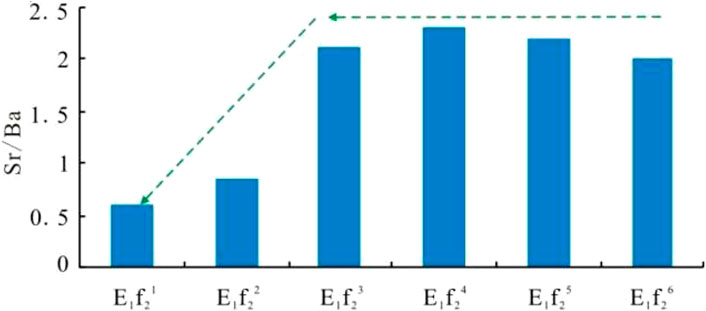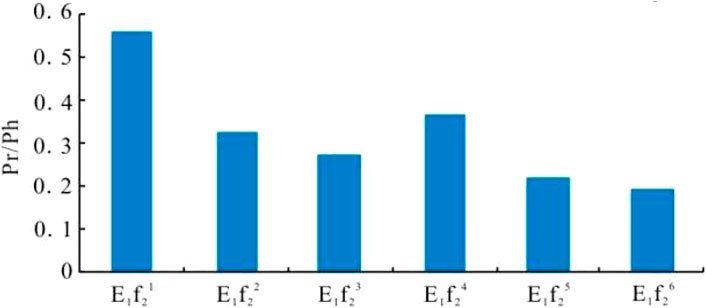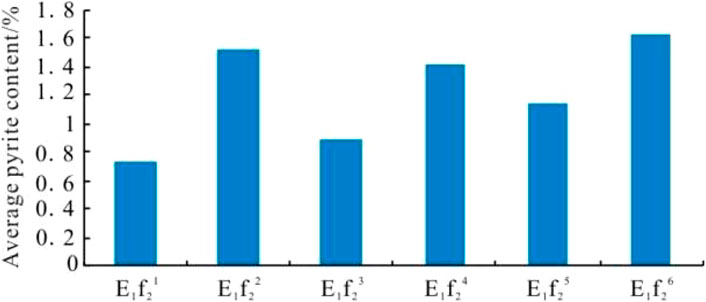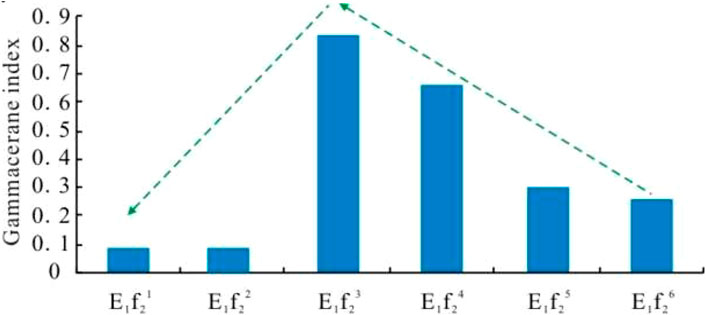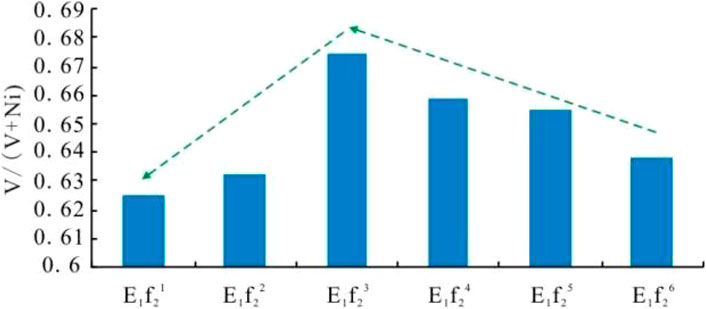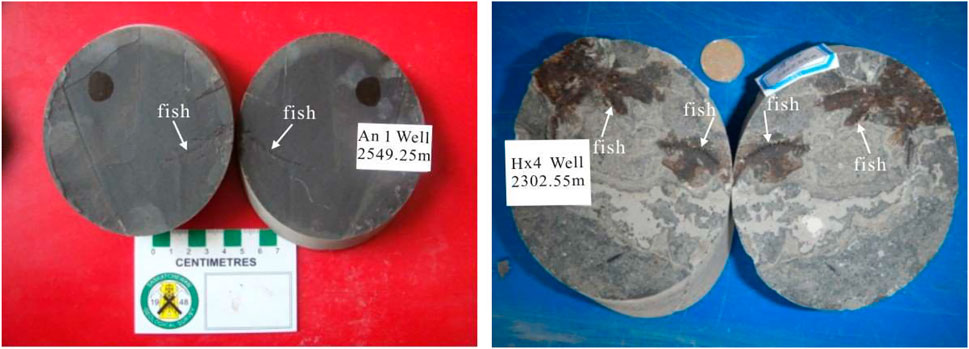- 1School of Geosciences, China University of Petroleum (East China), Qingdao, China
- 2Shandong Provincial Key Laboratory of Deep Oil and Gas, China University of Petroleum (East China), Qingdao, China
- 3Exploration and Development Research Institute of Qinghai Oilfield, CNPC, Dunhuang, China
- 4No.5 Oil Production Plant of Dagang Oilfield, CNPC, Tianjin, China
- 5Exploration and Development Research Institute of Shengli Oil Field, SINOPEC, Dongying, China
- 6Research Institute of Exploration and Development, Xinjiang Oilfield, CNPC, Karamay, China
- 7Geological Scientific Research Institute of Jiangsu Oilfield, SINOPEC, Yangzhou, China
Although the potential of lake facies shale oil and gas resources is enormous, the lithology is complex, heterogeneous, and obviously controlled by a sedimentary environment. By integrating cores, thin sections, X-ray diffraction analysis, trace elements, organic geochemical indexes, and paleontological data, this work studies sedimentary environment elements and sedimentary model of shale in the E1f2 member, Gaoyou Depression, Subei Basin. The shale in the E1f2 member is completely shore lacustrine deposits forming into the hot dry climate of tropical central and south Asia. The lake basin extended continuously, with brackish water, strong reduction, and medium water stratification. The transgression resulted in the rapid rise of water, salinity, reducibility, and water stratification. As the climate becomes wetter, the E1f2 water level, salinity, reduction, and stratification decrease. The shale in E1f2 members is characterized by sedimentary zones, which are divided into muddy water desalination deposit in the flooded zone, clear water salinization deposit in the transition zone, and still water salinization deposited in the clear water zone. Under palaeotopography settings of E1f2 members, combining characteristics of vertical stratification and the plane zone of the lake, an integrated sedimentary model of lacustrine shale in a flat platform has been established under climate and transgression control. The plane area of the lake could be divided into the slow slope zone, sub-depression zone, processes zone, deep slope zone, and deep depression zone, corresponding roughly to the sedimentary zones of the flooded zone, transition zone, and clear water zone. Moreover, the oil shale enriched in low-lying parts of the paleotopography is mainly deposited at the end of muddy water areas and clear water areas.
1 Introduction
As the exploration and development of conventional oil and gas reservoirs is becoming increasingly difficult in China, the exploration targets have been turned to low permeability, ultralow permeability unconventional oil and gas reservoirs. As an important unconventional resource, shale oil and gas have the characteristics of continuous distribution, self-generation and self-accumulation, and large reserves compared with conventional oil and gas (Zou et al., 2011; Liu et al., 2019; Xu et al., 2020a; Liu et al., 2020). In recent years, the theory and technology of shale oil and gas exploration and development have been developed rapidly, especially in North America. In Paleogene source rock of the Biyang Depression, Zhanhua Depression, Dongying Depression, Jinghu Depression, and Gaoyou Depression in China, shale oil wells of low production have also been drilled, which indicates good prospects for exploration and development. With further investigation of the Paleogene shale of the eastern basin in China, researchers found that the heterogeneity of lacustrine shale is stronger than that of marine shale, which is ultimately determined by various sedimentary environments. The range of the lake basin is small, and it is greatly influenced by the source and climate of the land, resulting in various and frequent changes of shale lithologies (Xu et al., 2014; Liu B et al., 2015; Zou et al., 2015; Xu et al., 2020b; Pan et al., 2020; Liu et al., 2021).
Lithologies are the most direct reflection of the sedimentary environment (Robert and Stephen, 2007). Their characteristics are determined by the combined action of the source, climatic and hydrodynamic conditions, water salinity, redox conditions, and water depth (Robert and Stephen, 2007; Chen et al., 2019). Therefore, lithology, rock color, sedimentary structure, special minerals, fossils, lithofacies assemblage, and distribution can directly reflect the sedimentary environment (Milliken et al., 2012; Qin et al., 2018). There are multiple sedimentary mixtures of mechanical, chemical, and biological deposits in the shale sedimentary environment, which is the source of complex shale lithofacies. The study of the shale sedimentary environment focuses more on the comprehensive analysis of paleoclimate, paleosalinity, paleoredox, and paleowater depth. Deng and Qian (1993) took the Dongying Depression as an example, studied the shale sedimentary environment in detail from a geochemistry perspective, and established a comprehensive division scheme of the lacustrine shale sedimentary environment. Similarly, Loucks and Ruppel (2007) studied the sedimentary interface, hydrodynamics, oxygen content, lithofacies, and paleontological distribution in the sedimentary environment of the Barnett Shale and established the marine shale sedimentary model. The geochemical method is an important means to restore the paleosedimentary environment according to the enrichment and distribution of elements in rocks, which are controlled by provenance, sedimentary mode, and sedimentary process (Deng and Qian, 1993; Zhang et al., 2019). The common method is to characterize the sedimentary environment qualitatively, semiquantitatively, and quantitatively by the content or ratio of trace elements in rocks (Deng and Qian, 1993; Tribovillard et al., 2006; Qian et al., 2012). Based on the study of rocks and minerals, the elemental geochemical method is the most widely used method in the analysis of sedimentary environmental conditions combined with other indicators to carry out a comprehensive study (Qian et al., 2012), including climate, salinity, redox conditions, water depth changes, water stratification, and sedimentary environment evolution (Walker and Price, 1963; Couch, 1971; Mei and Liu, 1980; Qian and Shi, 1982; Lan et al., 1987; Jones and Manning, 1994; Yan and Zhang, 1996; Zheng and Liu, 1999; Tonger et al., 2004; Li and He, 2008; Lin et al., 2008; Yin et al., 2009). At present, with the deepening of shale study, the strong heterogeneity and rapid lateral change in the lacustrine shale indicate that the sedimentary environment has characteristics of the microenvironment area in plane, and the impact of the bottom topographic and event sedimentation is greater in the lake basin. According to lithofacies differences in different parts of the basin, the semi-deep lake and deep lake sedimentary facies of the lower Es3 member in the Dongying Depression are subdivided into flat-broad semi-deep lacustrine microfacies, submerged uplift semi-deep lacustrine microfacies, deep depression microfacies, turbidite outer edge microfacies, and subaqueous fan-front microfacies (Zhang et al., 2014). Based on the aforementioned analysis, the sedimentary environment of the lacustrine shale is more difficult to restore, and there is no suitable sedimentary model. However, geochemical methods and lithofacies characterization are effective research methods of the shale sedimentary environment.
To explore the sedimentary environment characteristics of the lacustrine shale, this study took the E1f2 member of the Gaoyou Depression in the Subei Basin as an example. The analysis of sedimentary elements including paleoclimate, paleosalinity, paleoredox, paleodepth change, and water stratification, revealed the characteristics of the shale sedimentary area, restored sedimentary environment evolution, and established the sedimentary comprehensive model of the E1f2 member in the Subei Basin.
2 Overview of the Study Area
The Subei Basin is the land part of the Subei–South Yellow Sea Basin, located in the north of the Yangtze River in Jiangsu Province, with an area of about 3.5 × 104 km2. The basin borders on the Sulu–Binhai uplift in the north connect with the Zhangbaling–Sunan uplift in the south, reach the Tanlu fault in the west, and adjoin the Yellow Sea in the east. As the Meso-Cenozoic continental facies basin develops on the lower Yangtze activation platform, it mainly contains the Golden Lake Depression, Gaoyou Depression, Yanfu Depression, Haian Depression, and Yancheng Depression (Figure 1A; Ma et al., 2016). Among them, the most abundant oil and gas resources are in the Gaoyou Depression, and the E1f2 member represents the second member of the Funing Formation of the Paleogene, which is also one of the main source rocks. The E1f2 member belongs to one complete third-order sequence, which consists of the lacustrine low-stand system tract, lacustrine transgressive system tract, lacustrine high-stand system tract, and lacustrine regressive system tract (Figure 1B). The lithologic association is black or dark gray shale intercalated with gray flaggy shale, marl, and brown oil shale, which is subdivided into six lithologic members of the E1f26 – E1f21 from the bottom to the top. The shale lithology of the E1f2 member of the Gaoyou Depression is complex, mainly including calcareous (dolomitic) shale, silty mudstone, argillaceous siltstone, calcareous (dolomitic) siltstone, argillaceous limestone (dolomite), and silty limestone (dolomite) (Figure 2A–F). In addition, it mainly develops three sedimentary structures: sheet-like, lamellar, and massive (Figure 2G–I).
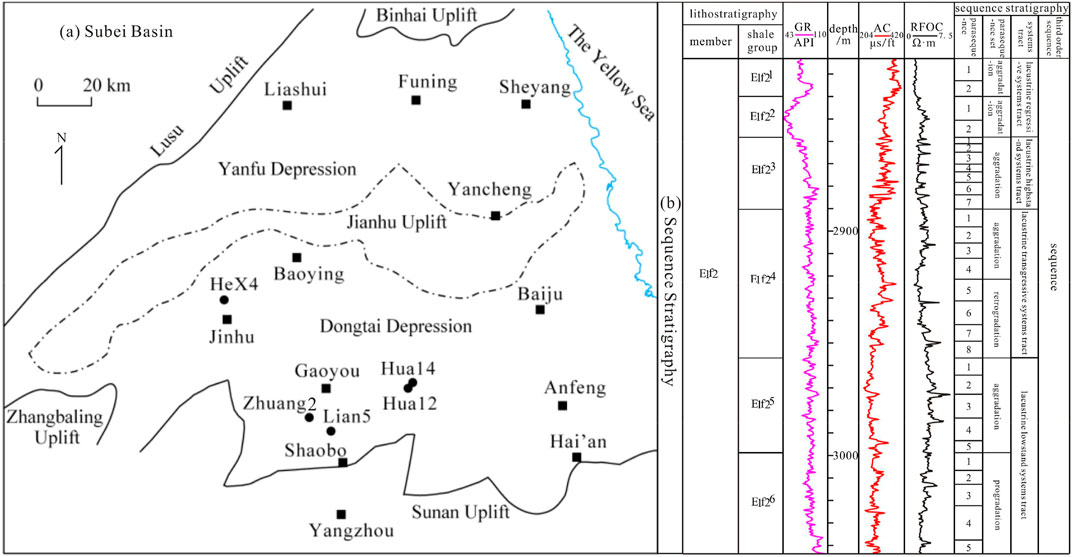
FIGURE 1. Structural units and stratigraphy framework of the Subei Basin. (A) Subei Basin; (B) sequence stratigraphy.
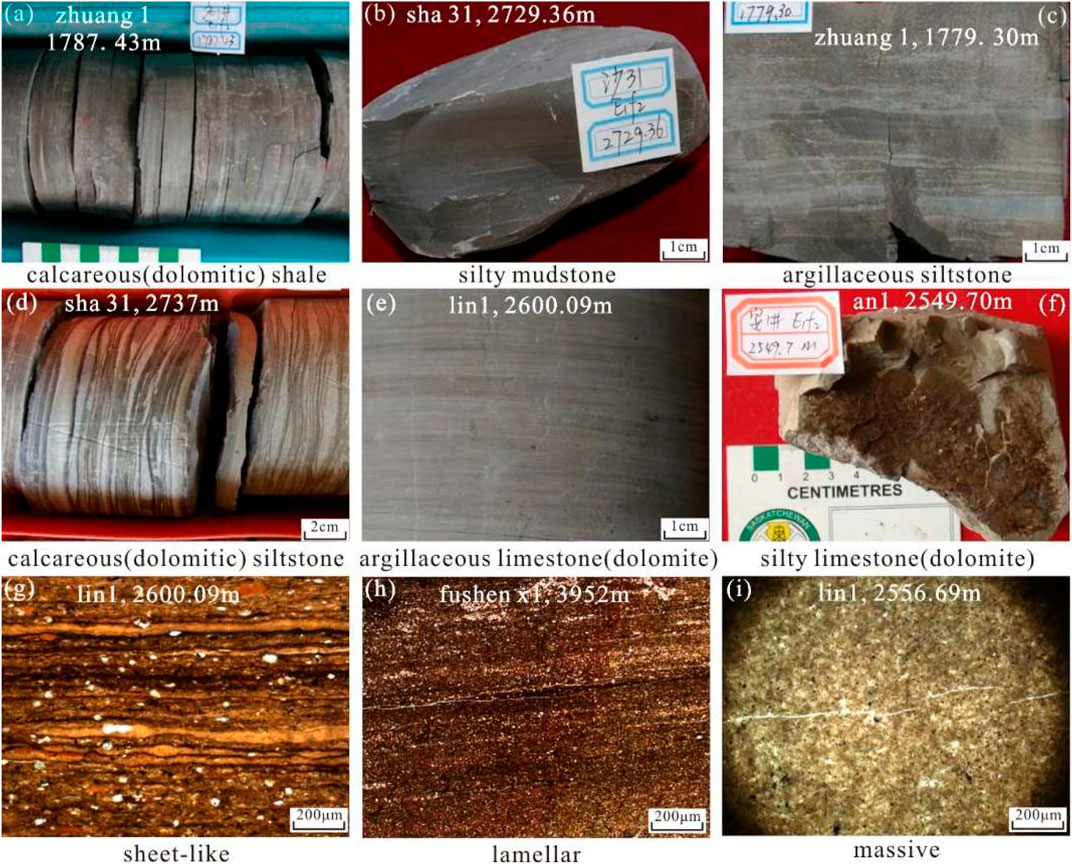
FIGURE 2. Main lithology types of E1f2 member in the Gaoyou Depression of the Subei Basin. (A) calcareous (dolomitic) shale, core photo, zhuang 1, 1787.43 m; (B) silty mudstone, core photo, sha 31, 2729.36 m; (C) argillaceous siltstone, core photo, zhuang 1, 1799.30 m; (D) calcareous (dolomitic) siltstone, core photo, sha 31, 2737 m; (E) argillaceous limestone (dolomite), core photo, lin 1, 2600.09 m; (F) silty limestone (dolomite), core photo, an 1, 2549.70 m; (G) sheet-like sedimentary structure, microscopic photo, lin 1, 2600.09 m; (H) lamellar sedimentary structure, microscopic photo, fushen x1, 3952 m; (I) massive sedimentary structure, microscopic photo, lin 1, 2556.69 m.
3 Methods
Based on core observation and description, 120 shale samples were selected for X-ray diffraction, rock-mineral observation, and fossil identification to analyze the sedimentary environmental conditions of the E1f2 member in the Gaoyou Depression.
To get the whole rock’s mineral content, the samples were ground into a 100-mesh powder and tested by X-ray diffraction using an X ′Pert PRO MPD instrument according to industry standard SY/T 5163-2010. The paleoclimate was indicated by sporopollenin and gypsum contents; paleoredox by the pyrite content; the change in the water depth by organic matter, feldspar mineral, carbonate mineral, and clay mineral contents; water stratification by bedding types; transgression by the fossil types; and the sedimentary province by the types and distribution of lithologies. The palynology was observed using a Panthera TEC-EpiPOL digital reflection polarizing microscope according to industry standard SYT 5915-2000. The organic matter content of 200-mesh powder samples was measured by using a LECO CS 744 carbon and sulfur analyzer according to industry standard GB/T 19,145-2003. Based on the study of rock mineral indicators, this work mainly studied sedimentary environmental conditions of the E1f2 member shale in the Gaoyou Depression by elemental and organic geochemical methods completed according to industry standard SY/T 5779-2008 and international standard ISO/TS 16965-2013, respectively. The Sr/Cu ratio was used to indicate paleoclimate, and the B element, Sr/Ba ratio, and Couch method were used to indicate paleosalinity. The Pr/Ph ratio was used to indicate paleoredox (Mei and Liu, 1980), and gammacerane index and V/(V + Ni) ratio were used to indicate water stratification, and changes of geochemical indicators were used to indicate the evolution of the sedimentary environment.
3 Results and Discussion
3.1 Analysis of Sedimentary Elements
3.1.1 Paleoclimate
3.1.1.1 Pollen
In palaeoclimate research, the palynology combination method is the most effectual. Spore powder comes from spore plants and seed plants, with characteristics such as small volume, large quantity, stable property, and significant matrix attributes. The pollen of the E1f2 member is the main ulmaceae pollen, and second is quercus and lacquer, and the pollen assemblage indicates the central and South Asian tropical climate (Yan et al., 1979; Wang and Shen, 1992).
3.1.1.2 Sr/Cu
Due to the influence of climate, the migration and enrichment of elements are different under different hydrothermal conditions. According to the characteristic of the element, the paleoclimatic characteristics of geologic time can be recovered by using the content and ratio of specific elements in sedimentary rocks (Wang et al., 1997; Xu et al., 2010; Xu et al., 2012). Sr/Cu is usually used to judge palaeoclimatic characteristics. A Sr/Cu ratio between 1 and 10 indicates a hyperthermic climate, while when it is greater than 10, it indicates a dry–hot climate. The Sr/Cu ratio of the E1f2 member is generally greater than 10, while the ratio of E1f22 and E1f21 is relatively small, indicating that it is mainly a dry–hot climate, and later becomes warm and humid (Figure 3).
3.1.1.3 Gypsum Content
The type of rock and mineral is a suitable indicator for palaeoclimate. For example, tillite is a sign of cold climate, and evaporite is the sign of a dry–hot climate, the coal-bearing stratum is the sign of a warm climate, and marine carbonate rock is the sign of a torrid climate (Lee et al., 2009). Large areas of eastern China are mainly red clastic deposits from the early Paleogene. At the same time, there are certain contents of gypsum in the E1f2 member of the Gaoyou Depression, and the gypsum content decreases in E1f22 and E1f21, which are in line with the characteristics of the paleoclimate reflected by the Sr/Cu ratio (Figure 3), indicating a dry–hot climate and becoming warm and humid later (Figure 4).
3.1.2 Paleosalinity
3.1.2.1 Boron Element
The boron content can qualitatively reflect the salinization degree of paleoaquifers (Li and Xiao, 1988). The content of boron in modern freshwater lake sediments was 30–60 ppm (Deng and Qian, 1993), but the average content of boron was greater than 60 ppm in the E1f2 member of the Gaoyou Depression, reflecting the high salinity of water (Figure 5).
3.1.2.2 Sr/Ba Ratio
The Sr/Ba ratio is a common semiquantitative index of the paleosalinity analysis, and its principle is that Ba is first precipitated in the form of BaSO4 with the increase in water salinity, while Sr to form SrSO4 precipitates needs higher water salinity. Therefore, the selective precipitation of the two elements was produced under certain salinity. In general, the Sr/Ba value in freshwater sediments is less than 0.6, while the Sr/Ba value in saltwater sediments is more than 1 (Qian and Shi, 1982; Deng and Qian, 1993; Zheng and Liu, 1999). Sr/Ba of E1f26-E1f23 in the Gaoyou Depression was more than 2, reflecting that the salinity of the water is high, while the Sr/Ba value of E1f22 and E1f21 decreased obviously, reflecting a decrease in salinity decreases (Figure 6).
3.1.2.3 Couch Method
The main reason for boron enrichment is the adsorption of clay minerals. In the case of excluding the effect of the source, scholars used the content of boron, the type, and content of clay minerals to calculate the salinity of water quantitatively. The most widely used method is the Couch formula, which was put forward by Couch (1971) in the study of Tertiary strata in the Niger River region, taking the adsorption effect of clay minerals on boron elements into account. Because terrigenous clastic in the Gaoyou Depression is mainly feldspar and quartz, the content of inherited boron could be ignored. The diagenesis intensity is medium for the E1f2 member. The impact of the clay mineral transformation was small, and then the Couch formula was still used to calculate water salinity. The ratio of the adsorption capacity of illite, montmorillonite, chlorite, and kaolinite to boron elements was 4:2:2:1, which is known from the experimental data. Therefore, the calculation equation of kaolinite boron is given in Eq. 1:
When the content of inherited boron is 0, the salinity is 1‰ and 35‰, corresponding to kaolinite boron of 1.3 and 65 ug/g, respectively. The relationship between boron and the salinity of kaolinite is obtained by substituting Freundlich adsorption isotherm (Eq. 2; Landergren and Carvajal, 1969).
Bk is kaolinite boron, μg/g; B is adsorption boron, μg/g; Xi, Xm, Xc, and Xk, respectively, represent the content of illite, montmorillonite, chlorite, and kaolinite, %; and Sp is palaeosalinity, ‰.
According to the calculation, the palaeosalinity of the E1f2 member in the Gaoyou Depression was 6.36–17.45‰, with an average value of 11.21‰. According to the partition standard of water salinity (Sun et al., 1997), it belongs to the environment of brackish water or mesohaline water.
3.1.3 Redox Property
Because of the heterogeneity of the sample, element geochemistry indexes often show contradictory problems when they indicate the redox property. However, the research area has abundant organic geochemical data and whole-rock and mineral analysis data, and then the ratio of the pristane/phytane (Pr/Ph) and pyrite content was used to make a comprehensive judgment on the redox property of the E1f2 member in the Gaoyou Depression.
The distribution characteristics of isoprenoid alkanes in crude oil generated from source rocks in different sedimentary environments were statistically analyzed by Mei and Liu (1980). The crude oil of salt lake facies had the advantage of phytane, and Pr/Ph was less than 0.8, reflecting a strong reducing environment. Lacustrine oil makes a balance of pristane and phytane, and Pr/Ph was 0.8–2.8, reflecting a reducing environment. Limnetic facies have the advantage of pristane, and the Pr/Ph ratio was 2.8-4, reflecting a weak oxidic and weak reductive environment. According to this, the Pr/Ph value of the shale in the Gaoyou Depression was less than 0.6, which is a strongly reducing environment. Pr/Ph of E1f21 increased later, indicating an increase in the degree of reduction (Figure 7).
Authigenic mineral containing iron in sedimentary rocks is the most commonly used redox mark. The order of occurrence of iron-bearing authigenic minerals reflects the redox conditions of the sedimentary environment. Limonite and hematite represent the oxidic environment, glauconite and scaly chlorite are the reflections of a weak oxidic and reductive environment, siderite appears in a reducing environment, and the enrichment of marcasite, pyrite, or ankerite usually indicates a strong reducing environment (Liu and Zeng, 1985; Deng and Qian, 1993). The strawberry-shaped pyrite is commonly developed in the E1f2 member of the Gaoyou Depression, indicating a strong reducing environment, which was consistent with the conclusion that the Pr/Ph ratio reflects. The pyrite content in E1f21 decreases, and the degree of reduction decreases (Figure 8).
3.1.4 Water Depth Change
It is difficult to judge the change in the water depth in shale strata. Therefore, elemental geochemistry is commonly used (Zhou et al., 1998; Wu and Zhou, 2000), but the rationality of the results is largely limited to the number of samples. This study used the abundant test data of organic carbon and whole-rock minerals in the Gaoyou Depression. The changes of organic carbon content and inorganic mineral content were combined to judge the change in water depth.
In a lake environment, the accumulation of organic matter is usually determined by the preservation conditions of organic matter (Ren and Lin, 2006). The deeper the water is, the better the preservation condition will be and then the higher the probability of organic matter enrichment will be. Therefore, the change in the organic carbon content can qualitatively reflect the large-scale change in the water depth. In fact, due to the source of the organic matter, the primary yield of organic matter, rate of microbial degradation, and terrigenous clastic dilution, when the change in the organic carbon content is used to indicate the small-scale change of water depth, the change of inorganic mineral content should also be combined (Blatt and Totten, 1981).
The E1f2 member of the Gaoyou Depression has characteristics of the organic carbon content increasing constantly from the bottom to the top (Figure 9A), felsic mineral and clay mineral contents reducing first and then increasing later (Figure 9B,C), and carbonate minerals content increasing first and then reducing later (Figure 9D). Specifically speaking, the contents of felsic minerals, clay minerals, and carbonate minerals of E1f26 and E1f25 were high, while the organic carbon content was low, which indicates that the water was shallow and closer to the land. In E1f24, felsic minerals and clay minerals were reduced to the minimum, carbonate minerals increased to the maximum, while the organic carbon content increased rapidly, indicating that the water rapidly deepened. In E1f23, felsic minerals and clay minerals began to increase, carbonate minerals began to decrease, while the organic carbon content continued to increase, indicating that the water continued to deepen and tended to be stable. There was a significant increase in felsic minerals and clay minerals of E1f22 and E1f21, carbonate minerals decreased significantly, while the organic carbon content reached the maximum, indicating that water was still in the deep background but slightly decreased. Therefore, shale in the E1f2 member of the Gaoyou Depression was formed in the background of lake transgression. It experienced the process of shallow water in the early stage, rapidly deepening in the middle stage, slow deepening and stabilization in the later stage, and slightly declining at the end.
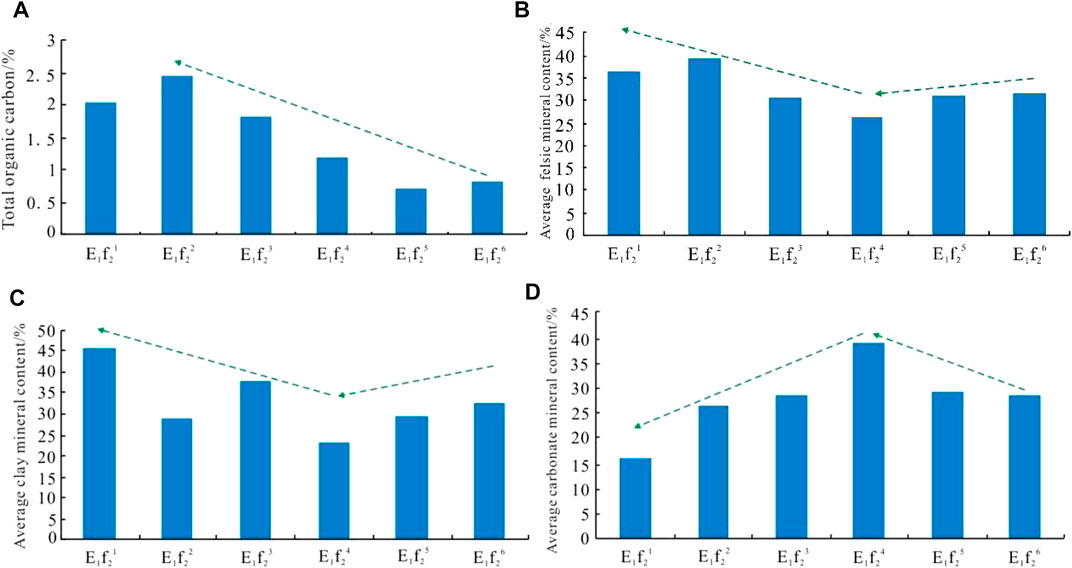
FIGURE 9. Variation of average composition of E1f2 member in the Gaoyou Depression of the Subei Basin. (A) On the whole, total organic carbon increases from E1f26 to E1f21. (B) Average felsic mineral content decreases first and then increases from E1f26 to E1f21, reaching minimum at E1f24. (C) On the whole, average clay mineral content decreases first and then increases from E1f26 to E1f21, reaching minimum at E1f24. (D) Average carbonate mineral content increases first and then decreases from E1f26 to E1f21, reaching maximum at E1f24.
3.1.5 Water Stratification
The stratification and mixture of the lake water have an important influence on the bloom of algae, consumption and preservation of organic matter, and redox of the water. During the deposition of the E1f2 member, the lake basin was located in the central-south subtropical zone, and the salinity of the water was significant. Seasonal water stratification usually occurs under the action of density differences caused by temperature and salinity. The application of geochemical indicators to study water stratification has achieved good results (Zhang et al., 1999; Liu MY et al., 2015). The formation of lamellation was closely related to the water stratification in the lake (Yuan et al., 2015). Therefore, the gammacerane index and V/(V + Ni) used in this study and bedding types were combined to judge the water stratification. The bigger the gammacerane index or V/(V + Ni) is, the more the lamellation develops, indicating that water stratification is stronger. Both gammacerane index and V/(V + Ni) in the Gaoyou Depression have the trend of early increase, medium stable, and late decrease (Figures 10, 11).
3.2 Sedimentary Environment Evolution
3.2.1 Transient Transgression
The Subei Basin belongs to the offshore continental lake basin. Scholars have further arguments about whether the E1f2 member was subjected to transgression from aspects of paleontology, lithology, and geochemistry (Yan et al., 1979; He, 1987; Yuan et al., 2005; Fu et al., 2007). Pieces of palaeontological evidence show that the E1f2 member had been affected by transgression.
This study focused on the analysis of the sedimentary environment represented by two fish fossils preserved in E1f23 (Figure 12). Both fish fossils were preserved in shale with a high gypsum content. The fish fossil in E1f23 shale of An1 well in the Haian Depression belongs to Clupeidae, which lives in the marine environment, indicating that the shale deposition is related to transgression. The fish fossil of Hx4 well in E1f23 shale in the Jinhu Depression belongs to Bagridae, which usually lives in a freshwater environment, indicating that the shale deposition is related to injection of river freshwater. According to this, the E1f23 shale in the Subei Basin suffered transgression, which belongs to an offshore lake deposit of high salinity. The Jinhu Depression is closer to the west coast than the Gaoyou Depression and the Haian Depression. The transgression not only salted the water, facilitating the deposition of gypsum and the flourishing of organisms, but also led to the rapid expansion of the water body and the enhancement of stratification, making the E1f23 oil shale almost cover the entire basin.
3.2.2 Overall Evolution Law
The sedimentary elements in the lake were not independent of each other. Among them, palaeoclimate was the basic sedimentary element, which determines the salinity, redox, water depth, and stratification of the lake. On the basis of a single index analysis, a comprehensive analysis of multiple indexes was carried out. On the whole, the E1f2 member of the Gaoyou Depression in the Subei Basin is generally a dry–hot climate deposit, and later has a tendency to become wet, which makes the evolution of the sedimentary environment show corresponding regularity (Figure 13). From the bottom to the top, during the sedimentary period of E1f26 and E1f25, the water depth was relatively shallow, the lake basin was relatively closed, and water stratification was medium, which belonged to the environment of brackish water and a strong reduction. Because it was near the front of the beach bar, lithologies were mainly gray (green)-layered or massive argillaceous siltstone, silty mudstone, and lime mudstone. During the sedimentary period of E1f24 and E1f23, water expanded rapidly, water stratification strengthened, and salinity and reducibility increased. The lithologies were mainly dark gray lamellar or flaggy calcareous (dolomitic) mudstone, silty mudstone, marl, and brown oil shale. Brown oil shale widely developed in E1f23. During the sedimentary period of E1f22 and E1f21, due to the humid climate, the lake basin area was larger, water was relatively deep but slightly declined later, sealing property was reduced, water stratification was abated, and salinity and reducibility decreased, which was particularly evident in the sedimentary period of E1f21. The lithologies were mainly (dark) gray massive argillaceous siltstone, silty mudstone, and calcareous mudstone. Even at the top of E1f21, flaggy sandstone with wave ripple cross-bedding of high-level delta developed. E1f26-E1f21 was formed in a certain depth of water, dry heat, brackish water, reducing environment, and medium stratification, and the corresponding water depth, paleoclimate, paleosalinity, paleooxygenation facies, and water delamination were strengthened first and then weakened and then strengthened.
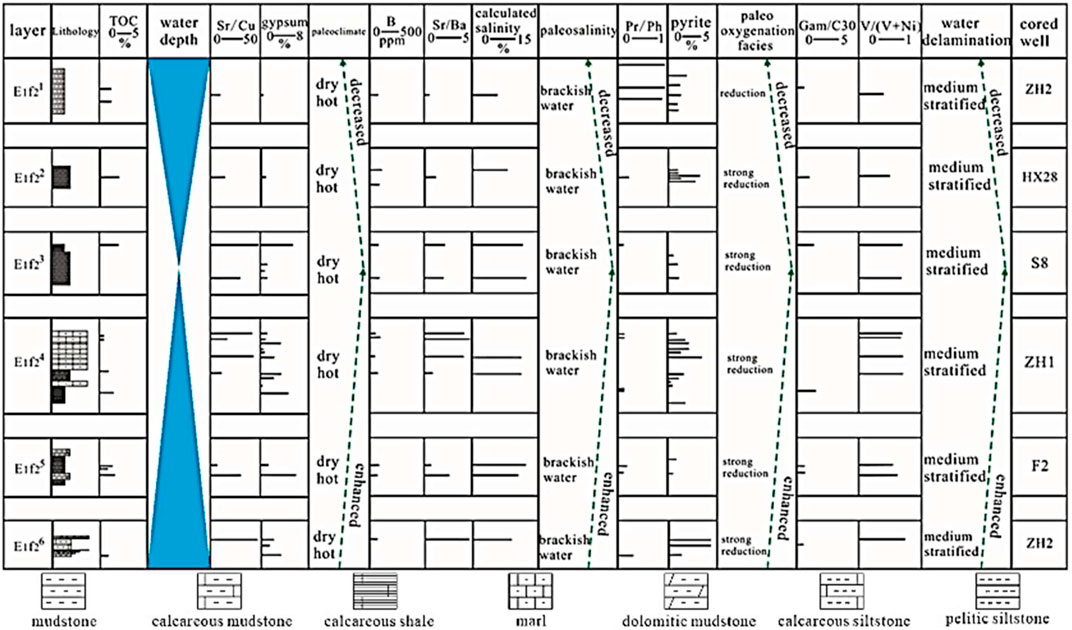
FIGURE 13. Sedimentary environment evolution of E1f2 member in the Gaoyou Depression of the Subei Basin.
3.2.3 Sedimentary Zone
The lake basin is small in area and greatly influenced by the source and climate (Xu et al., 2014), resulting in an obvious sedimentary environment zone. The most important component of the sedimentary environment is the sediments. When the sedimentary environment changes, the sedimentary elements change, causing the sediments to change. From the edge to the center of the lake basin, sedimentary elements gradually change, and regular lithologic zones and changes appear in the plane. Oxygen-rich sandstone, siltstone, and mudstone of the river-delta system are at the edge of the lake basin, oxygen-poor gray silty mudstone, calcareous mudstone, oolitic limestone, and biogenic limestone are at the slope of the lake basin, and anaerobic black organic-rich shale is in the center of the basin. Therefore, the lithologic zone can indicate the distribution of sedimentary environment, and then lithologic changes reflect the change of sedimentary environment.
By analogy with modern sedimentation, when rivers flow into a large lake or ocean, there are three different sedimentary zones: flooded zone, transition zone, and freshwater zone. The flooded zone has been affected by flood water for a long time in the edge of the lake basin, the clear water zone was hardly affected by flood water in the center of the lake basin, while the transition zone was between the flooded zone and the clear water zone in the slope of the lake basin. In the flooded area, water was turbid due to the impact of sources, strong hydrodynamic force, and rich in silt and clay minerals. Water salinity desalinates as brackish water due to river water injection. Since the water is shallow and above the wave base, water stratification is weak, which shows a weak oxidation–reduction environment. The sediments are mainly mechanical deposits, mainly including fine-grained sediments such as gray (gray-green) layered or massive argillaceous siltstone, silty mudstone, and mudstone, in addition to coarse clastic rocks. In the clear water zone, water is clear but contains colloid-grade suspended microparticles such as clay minerals, organic matter, and carbonate minerals. Water is salty and belongs to the brackish water environment. Due to the fact that water is deep and quiet, it often has strong water stratification and strong reduction, which are favorable to the preservation of organic matter. The sediments are mainly (colloidal) chemical deposits (Cai, 2004), which primarily include gray-black or brown oil shale and rock salt. In the transition zone located on the platform where upwelling develops, the influence of the source is small, and water is turbulent and relatively clean due to the flourishing of organisms. Water conditions are mainly in brackish water, medium water stratification, and reduction environment. Mechanical, chemical, and biological depositions coexist or appear alternately, resulting in lithology diversity, such as flaggy or lamellar (dark) gray oolitic limestone, oolitic mudstone, biolithite, marl, lime mudstone, silty mudstone, and mudstone. According to the characteristics of sedimentary zones and sedimentary factors, sedimentary types of the E1f2 member in the Gaoyou Depression are divided into two categories: muddy water desalination deposit and clear water salinization deposit. The muddy water desalination deposit belongs to the flood zone, which is characterized by the turbidity and low salinity of water. The clear water salinization deposit consists of clean water salinization deposit in the transition zone and still water salinization deposit in clear water zone, which are characterized by the limpidity and high salinity of water (Table 1).

TABLE 1. Sedimentary zones and characteristics of E1f2 member in the Gaoyou Depression of the Subei Basin.
3.2.4 Sedimentary Model
The complete sedimentary model should include tectonic background, source supply, lithofacies type and distribution, water condition, and biological development (Loucks and Ruppel, 2007). The Subei Basin is located in the transitional position between the sea and the land, which belongs to the offshore continental lake basin. The shale in the E1f2 member is mainly controlled by climatic conditions and affected by transitory transgression. Under dry and hot climatic conditions of the central-south subtropical area, the periodic vertical water stratification of the lake leads to the plane distribution of sediments. There are multiple reasons for the vertical water stratification of the lake, such as hydrodynamic stratification, water transparency stratification, temperature stratification, and biological differentiation. However, these water stratification reasons are not independent but interrelated. There are mainly four types of physicochemical interfaces or zones in the lake. To be specific, the first belongs to hydrodynamic interfaces including lake level, sunny wave base, and storm wave base. The second is related to optical stratification, including photic zone, disphotic zone, and aphotic zone. The third is related to temperature stratification, including epilimnion, thermocline, and hypolimnion. The fourth is related to salinity like halocline. These physicochemical interfaces tend to overlap and are also where the surface and laminar flows occur (Deng and Qian, 1993; Lee et al., 2009; Tulipani et al., 2015). Sedimentary zones defined by stratification interfaces have different sedimentary conditions, which determine the types of sediments and organisms and form sedimentary zones of the lake basin.
During the sedimentary period of the E1f2 member in the Subei Basin, the palaeotopography is a large slope and develops a basalt platform on the western boundary of the Gaoyou Depression. Under the tectonic background, a comprehensive sedimentary model of the gentle platform of the E1f2 member in the Subei Basin was established by combining the characteristics of sedimentary zones (Figure 14). According to the sedimentary conditions such as palaeotopography, water transparency, hydrodynamic conditions, and biological distribution, the plane area of the lake can be divided into the slow slope zone, sub-depression zone, processes zone, deep slope zone, and deep depression zone, which correspond roughly to the flooded zone, transition zone, and clear water zone in sedimentary zones (Figure 14).

FIGURE 14. Comprehensive sedimentary model of E1f2 member in the Gaoyou Depression of the Subei Basin.
Within the paleoclimatic background influenced by transgression, under the control of water conditions such as source supply (e.g., fluvial delta), hydrodynamics (e.g., river, wind, wave, and turbidity current), temperature, salinity, water stratification, and biological community, felsic minerals, carbonate minerals, clay minerals, and organic matter regularly deposit in different tectonic positions of the lake basin, which generates a sandstone–mudstone sedimentary zone, carbonate sedimentary zone, and oil (gypsum–salt) shale sedimentary zone in the plane. Among them, muddy desalination water deposits of the flooded zone that are greatly influenced by the source are mainly deposited in the western and central Jinhu Depression. Clean water salinization deposits of transition areas are mainly deposited in the eastern Jinhu Depression and western Gaoyou Depression. Still, water salinization deposits of the clear water zone are mainly deposited in the eastern Gaoyou Depression and Haian Depression.
According to the sedimentary model, the oil shale develops in the transition period from a hot–dry climate to the humid climate, and the water medium conditions are still water, brackish water, strong reduction, and water stratification. The oil shale is mainly deposited at the end of the muddy water area and clear water area far away from coarse clastic minerals and is enriched in low-lying parts of palaeotopography, such as deep depressions, local sub-depressions on the basin slope, and low-energy parts before and after local prominence or slope break belt. Different from the development environment of oil shale, bioclastic limestone is developed on the local prominence of the slope.
5 Conclusion
1) Lacustrine shale of the E1f2 member in the Gaoyou Depression of the Subei Basin is formed in the offshore continental lake basin with brackish water, reduction or strong reduction, continuous transgression, and medium water stratification controlled by the south central hot dry subtropical climate.
2) Lacustrine shale of the E1f2 member in the Gaoyou Depression of the Subei Basin is a dry–hot climate deposit of central south subtropical, which becomes wet in the later stage. The salinity of the water is brackish, which is the largest in E1f23 and decreases in the later stage. The water condition is reduction–strong reduction, which decreases in the later stage. The water as a whole is in the background of transgression, which decreases slightly in the later stage. The water has medium water stratification, which is the strongest in E1f23 and weakens later. The preserved fossils of Clupeidae and Bagridae in E1f23 shale indicate that the E1f2 member was affected by freshwater injection and transient transgression.
3) Lacustrine shale of the E1f2 member in the Subei Basin is characterized by the sedimentary zone, including muddy water desalination deposit in the flooded zone, clean water salinization deposit in the transition zone, and still water salinization deposit in the clear water zone. The flooded zone is affected by the source for a long time and characterized by continuous dynamic, turbidity, brackish water, weak water stratification, and weak reduction, where gray (green) sandstone and mudstone mainly deposit. The clear water zone is not affected by the source and characterized by quiet clean brackish water, strong stratification and reduction, where gray-black oil (gypsum–salt) shale deposits. The transition zone between the flooded zone and the clear water zone is characterized by a periodic oscillation dynamic, relatively clean brackish water, medium water stratification, and reduction, where gray carbonate rocks mainly deposit.
4) Under the palaeogeomorphic background of the E1f2 member in the Subei Basin, combined with the characteristics of the vertical water stratification and plane sedimentary zone of the lake, a comprehensive sedimentary model of lacustrine shale controlled by climate and affected by transgression is established.
Data Availability Statement
The original contributions presented in the study are included in the article/Supplementary Material, further inquiries can be directed to the corresponding author.
Author Contributions
CM: methodology, writing–original draft and writing—review and editing. WH, KZ, XM, ZL and HY: data curation, formal analysis and writing—review and editing. SL: data curation, project administration, and funding acquisition.
Funding
This work was supported by the Natural Science Foundation of China (Grant Nos. 42172153, 41802172, and 41830431) and Fundamental Research Funds for the Central Universities (Grant No. 20CX02109A). Professor Liu Guanbang in the Earth Science Department of Nanjing University not only carried out detailed identification and analysis of the sedimentary environmental significance of two fish fossils preserved in E1f23 shale but also gave a detailed answer to the questions on the influence of transgression, oil shale genesis, and basalt eruption on biology and deposition by letter, providing valuable material and ideas for this article. Apart from that, the Geological Science Institute of SINOPEC Jiangsu Oilfield Branch has provided this study with valuable raw materials and test data for this study.
Conflict of Interest
Author SL and ZL were employed by the company SINOPEC. Author KZ, XM, and HY were employed by CNPC.
The remaining authors declare that the research was conducted in the absence of any commercial or financial relationships that could be construed as a potential conflict of interest.
Publisher’s Note
All claims expressed in this article are solely those of the authors and do not necessarily represent those of their affiliated organizations, or those of the publisher, the editors, and the reviewers. Any product that may be evaluated in this article, or claim that may be made by its manufacturer, is not guaranteed or endorsed by the publisher.
References
Blatt, H., and Totten, M. W. (1981). Detrital Quartz as an Indicator of Distance from Shore in marine Mudrocks. Sepm Jsr 51 (4), 1259–1266. doi:10.1306/212F7E7D-2B24-11D7-8648000102C1865D
Cai, J. G. (2004). Organic clay Complexes in Argillaceous Sediments and Mudstones. Beijing, China: Science Press, 1–216. (in chinese).
Chen, Y., Zhu, Z., and Zhang, L. (2019). Control Actions of Sedimentary Environments and Sedimentation Rates on Lacustrine Oil Shale Distribution, an Example of the Oil Shale in the Upper Triassic Yanchang Formation, southeastern Ordos Basin (NW China). Mar. Pet. Geology. 102, 508–520. doi:10.1016/j.marpetgeo.2019.01.006
Elton L. Couch, E. L. (1971). Calculation of Paleosalinities from boron and clay mineral Data. Bulletin 55 (10), 1829–1837. doi:10.1306/819a3dac-16c5-11d7-8645000102c1865d
Deng, H. W., and Qian, K. (1993). Sedimentary Geochemistry and Environmental Analysis. Lanzhou: Gansu Science and Technology Publishing, 4–31. (in chinese).
Fu, Q., Li, Y., Zhang, G. D., and Liu, Y. R. (2007). Evidence of Transgression Lake of Subei Basin During Late Cretaceous and Paleocene Epoch and its Geological Significance. Acta Sedimentol Sin 25 (3), 381–385. (in chinese). doi:10.14027/j.cnki.cjxb.2007.03.008
He, Y. (1987). Earle Tertiary Foraminifera from Northern Jiangsu, China. Acta Palaeontol. Sin 26 (6), 721–727. (in chinese).
Jones, B., and Manning, D. A. C. (1994). Comparison of Geochemical Indices Used for the Interpretation of Palaeoredox Conditions in Ancient Mudstones. Chem. Geol. 111 (1), 111–129. doi:10.1016/0009-2541(94)90085-x
Lan, X. H., Ma, D. X., Xu, M. G., Zhou, Q. W., and Zhang, G. W. (1987). Some Geochemical Indicators of the Pearl river delta and Their Facies Significance. Mar. Geol. Quat. Geol. 7 (1), 39–49. (in chinese).
Landergren, S., and Carvajal, M. C. (1969). Contribution to the Geochemistry of boron III. The Relationship between boron Concentration in marine clay Sediments and the Salinity of the Depositional Environments Expressed as an Adsorption Isotherm. Ark. Miner Geol. 5 (2), 11–22.
Lee, H. S., Yamashita, T., and Haggag, M. (2009). Modelling Hydrodynamics in Yachiyo Lake Using a Non-hydrostatic General Circulation Model with Spatially and Temporally Varying Meteorological Conditions. Hydrol. Process. 23 (14), 1973–1987. doi:10.1002/hyp.7337
Li, S. F., and He, S. (2008). Geochemical Characteristics of Dibenzothiophene, Dibenzofuran and Fluorine and Their Homologues and Their Environmental Indication. Geochimica 37 (1), 45–50. (in chinese). doi:10.19700/j.0379-1726.2008.01.006
Li, C. F., and Xiao, J. F. (1988). The Application of Trace Element to the Study on Paleosalinities in Sha Hejie Formation of Dongying Basin Sheng Li Oilfield. Acta Sedimentol Sin 6 (4), 100–107. (in chinese).
Lin, Z. J., Chen, D. F., and Liu, Q. (2008). Geochemical Indices for Redox Conditions of marine Sediments. Bull. Mineral. Petrol. Geochem. 27 (1), 72–80. (in chinese). doi:10.3969/j.issn.1007-2802.2008.01.012
Liu, B. J., and Zeng, Y. F. (1985). Lithofacies and Paleogeography Foundation and Working Method. Beijing: Geological Publishing House, 216–228. (in chinese).
Liu, B., Lv, Y. F., Meng, Y. L., Li, X. N., Guo, X. B., Ma, Q., et al. (2015). Petrologic Characteristics and Genetic Model of Lacustrine Lamellar fine-grained Rock and its Significance for Shale Oil Exploration: A Case Study of Permian Lucaogou Formation in Malang Sag, Santanghu Basin, NW China. Pet. Explor. Dev. 42 (5), 598–607. (in chinese). doi:10.1016/s1876-3804(15)30060-4
Liu, R., Hao, F., Engelder, T., Shu, Z., Yi, J., Xu, S., et al. (2019). Stress Memory Extracted from Shale in the Vicinity of a Fault Zone: Implications for Shale-Gas Retention. Mar. Pet. Geology. 102, 340–349. doi:10.1016/j.marpetgeo.2018.12.047
Liu, R., Hao, F., Engelder, T., Zhu, Z., Yi, J., Xu, S., et al. (2020). Influence of Tectonic Exhumation on Porosity of Wufeng-Longmaxi Shale in the Fuling Gas Field of the Eastern Sichuan Basin, China. Bulletin 104, 939–959. doi:10.1306/08161918071
Liu, R., Wen, T., Amalberti, J., Zheng, J., Hao, F., and Jiang, D. (2021). The Dichotomy in noble Gas Signatures Linked to Tectonic Deformation in Wufeng-Longmaxi Shale, Sichuan Basin. Chem. Geology. 581, 120412. doi:10.1016/j.chemgeo.2021.120412
Liu, M. Y., Hu, J. F., and Wan, X. Q. (2015). The Organic Geochemical Evidences for the lake Water Stratification in Lower Nenjiang Formation, Songliao Basin. J. Lake Sci. 27 (1), 190–194. (in chinese). doi:10.18307/2015.0122
Loucks, R. G., and Ruppel, S. C. (2007). Mississippian Barnett Shale: Lithofacies and Depositional Setting of a Deep-Water Shale-Gas Succession in the Fort Worth Basin, Texas. Bulletin 91 (4), 579–601. doi:10.1306/11020606059
Ma, C., Dong, C., Luan, G., Lin, C., Liu, X., and Elsworth, D. (2016). Types, Characteristics and Effects of Natural Fluid Pressure Fractures in Shale: A Case Study of the Paleogene Strata in Eastern China. Pet. Exploration Develop. 43 (4), 634–643. doi:10.1016/s1876-3804(16)30074-x
Mei, B. W., and Liu, X. J. (1980). The Distribution of Isoprenoid Alkanes in Chinese Crude Oil and its Relation with the Geologic Environment. Oil Gas Geol. 1 (2), 99–115. (in chinese).
Milliken, K. L., Esch, W. L., Reed, R. M., and Zhang, T. (2012). Grain Assemblages and strong Diagenetic Overprinting in Siliceous Mudrocks, Barnett Shale (Mississippian), Fort Worth Basin, Texas. Bulletin 96 (8), 1553–1578. doi:10.1306/12011111129
Pan, X., Wang, Z., Li, Q., Gao, J., Zhu, L., and Liu, W. (2020). Sedimentary Environments and Mechanism of Organic Matter Enrichment of Dark Shales with Low TOC in the Mesoproterozoic Cuizhuang Formation of the Ordos Basin: Evidence from Petrology, Organic Geochemistry, and Major and Trace Elements. Mar. Pet. Geology. 122, 104695. doi:10.1016/j.marpetgeo.2020.104695
Qian, K., and Shi, H. X. (1982). The Choice of the Method of Paleosalinity Determination in Resources Evaluation. Pet. Explor. Dev. 3, 32–38. (in chinese).
Qian, L. J., Chen, H. D., Lin, L. B., Xu, S. L., and Ou, L. H. (2012). Geochemical Characteristics and Environment Implications of Middle Jurassic Shaximiao Formation, Western Margin of Sichuan Basin. Acta Sedimentol Sin 30 (6), 1061–1071. (in chinese). doi:10.14027/j.cnki.cjxb.2012.06.020
Qin, J., Wang, S., Sanei, H., Jiang, C., Chen, Z., Ren, S., et al. (2018). Revelation of Organic Matter Sources and Sedimentary Environment Characteristics for Shale Gas Formation by Petrographic Analysis of Middle Jurassic Dameigou Formation, Northern Qaidam Basin, China. Int. J. Coal Geology. 195, 373–385. doi:10.1016/j.coal.2018.06.015
Ren, Y. J., and Lin, Y. X. (2006). Petroleum Geochemistry. Dongying: China University of Petroleum Press, 1–442. (in chinese).
Sun, Z. C., Yang, F., Zhang, Z. H., Li, S. J., Li, D. M., and Peng, L. C. (1997). Sedimentary Environment and Hydrocarbon Generation of Cenozoic saline Lakes in China. Beijing: Petroleum Industry Press, 1–338. (in chinese).
Tonger, B., Liu, W. H., Xu, Y. C., and Chen, J. F. (2004). The Discussion on Anoxic Environments and its Geochemical Identifying Indices. Acta Sedimentol Sin 22 (2), 365–372. (in chinese). doi:10.14027/j.cnki.cjxb.2004.02.026
Tribovillard, N., Algeo, T. J., Lyons, T., and Riboulleau, A. (2006). Trace Metals as Paleoredox and Paleoproductivity Proxies: An Update. Chem. Geology. 232 (1), 12–32. doi:10.1016/j.chemgeo.2006.02.012
Tulipani, S., Grice, K., Greenwood, P. F., Schwark, L., Böttcher, M. E., Summons, R. E., et al. (2015). Molecular Proxies as Indicators of Freshwater Incursion-Driven Salinity Stratification. Chem. Geology. 409, 61–68. doi:10.1016/j.chemgeo.2015.05.009
Walker, C. T., and Price, N. B. (1963). Departure Curves for Computing Paleosalinity from Boron in Illites and Shales. Bulletin 47 (5), 833–841. doi:10.1306/BC743A93-16BE-11D7-8645000102C1865D
Wang, R., and Shen, H. (1992). Utilization of Spore-Pollenina Quantitative Study of Paleoclimate. Pet. Sci. 13 (2), 184–190. (in chinese).
Wang, S. J., Huang, X. Z., Tuo, J. C., Shao, H. S., Yan, C. F., Wang, S. Q., et al. (1997). Evolutional Characteristics and Their Paleoclimate Significance of Trace Elements in the Hetaoyuan Formation, Biyang Depression. Acta Sedimentol Sin 15 (1), 66–70. (in chinese).
Wu, Z. P., and Zhou, Y. Q. (2000). Using the Characteristic Elements from Meteoritic Must in Strata to Calculate Sedimentation Rate. Acta Sedimentol Sin 18 (3), 395–399. (in chinese).
Xu, Z. J., Cheng, R. H., Wang, L. L., Zhang, L., and Li, F. (2010). Elemental Geochemical Characteristics of Tuffaceous Sediments and Tectonic Setting of Tangxia Formation of Middle Jurassic in Dongguan, Guangdong Province. Acta Petrol. Sin 26 (1), 352–360. (in chinese).
Xu, Z. J., Cheng, R. H., Zhang, L., Wang, L. L., and Kong, Y. (2012). The Geochemistry Records of Sea-Level Relative Movement and Paleoclimatic Evolution of the South China Continental Margin in Late Triassic-Early-Middle Jurassic. Earth Sci. J. China U Geosci. 37 (1), 113–124. (in chinese). doi:10.3799/dqkx.2012.011
Xu, W., Chen, K. Y., Cao, Z. L., Xiao, P., and Wang, W. T. (2014). Original Mechanism of Mixed Sediments in the Saline Lacustrine Basin. Acta Petrol. Sin 30 (6), 1804–1816. (in chinese).
Xu, S., Hao, F., Zhang, Y., and Gou, Q. (2020a). High-quality marine Shale Reservoir Prediction in the Lower Silurian Longmaxi Formation, Sichuan Basin, China. Interpretation 8 (2), T453–T463. doi:10.1190/INT-2019-0149.1
Xu, S., Gou, Q., Hao, F., Zhang, B., Shu, Z., Lu, Y., et al. (2020b). Shale Pore Structure Characteristics of the High and Low Productivity wells, Jiaoshiba Shale Gas Field, Sichuan Basin, China: Dominated by Lithofacies or Preservation Condition? Mar. Pet. Geology. 114, 104211. doi:10.1016/j.marpetgeo.2019.104211
Yan, J. X., and Zhang, H. Q. (1996). Paleo-oxygenation Facies: a New Research Field in Sedimentology. Geol. Sci. Technol. Inf. 15 (3), 9–10. (in chinese).
Yan, Q. S., Zhang, G. D., Xiang, L. S., Wu, P. Y., Dong, R. X., Wang, Y. Y., et al. (1979). Marine Inundation and Related Sedimentary Environment of Fu Ning Group (Lower Paleogene), in Jin Hu Depression, North Jiang Su Plain. Acta Geol. Sin 1, 74–84. (in chinese).
Yin, H. F., Xie, S. C., Qin, J. Z., Yan, J. X., and Luo, G. M. (2009). Discussion on Geobiology, Biogeology and Earth Biofacies. Sci. China Ser. D 38 (12), 1473–1480. (in chinese).
Yuan, W. F., Chen, S. Y., and Zeng, C. M. (2005). Research Development and Prospectson Paleogene Sea Transgression in Bohai Bay Basin. Acta Sedimentol Sin 23 (4), 604–612. (in chinese). doi:10.14027/j.cnki.cjxb.2005.04.007
Yuan, X. J., Lin, S. H., Liu, Q., Yao, J. L., Wang, L., Guo, H., et al. (2015). Lacustrine Fine-Grained Sedimentary Features and Organic-Rich Shale Distribution Pattern: A Case Study of Chang 7 Member of Triassic Yanchang Formation in Ordos Basin, NW China. Pet. Explor. Dev. 42 (1), 34–43. (in chinese). doi:10.11698/PED.2015.01.04
Zhang, L. P., Huang, D. F., and Liao, Z. Q. (1999). Gammacerane—geochemical Indicator of Water Column Stratification. Acta Sedimentol Sin 17 (1), 136–140. (in chinese).
Zhang, S., Chen, S. Y., Tan, M. Y., Zhang, Y. Y., Sun, B. B., Gong, W. L., et al. (2014). Characterization of Sedimentary Microfacies of Shale in the Lower Third Sub-Member of Shahejie Formation, Western Dongying Sag. Pet. Sci. 35 (4), 633–645. (in chinese). doi:10.7623/syxb201404003
Zhang, L., Xiao, D., Lu, S., Jiang, S., and Lu, S. (2019). Effect of Sedimentary Environment on the Formation of Organic-Rich marine Shale: Insights from Major/trace Elements and Shale Composition. Int. J. Coal Geology. 204, 34–50. doi:10.1016/j.coal.2019.01.014
Zheng, R. C., and Liu, M. Q. (1999). Study on Palaeosalinity of Chang-6 Oil Reservoir Set in Ordos Basin. Oil Gas Geol. 20 (1), 20–25. (in chinese).
Zhou, Y. Q., Wu, Z. P., and Shi, B. Q. (1998). Applications of Neutron Activation Analysis in Sequence Stratigraphy. Geosci. Front. 5 (1∼2), 143–149. (in chinese).
Zou, C. N., Tao, S. Z., and Hou, L. H. (2011). Unconventional Petroleum Geology. Beijing: Geological Publishing House, 1–310. (in chinese).
Keywords: E1f2 member, sedimentary element, sedimentary evolution, sedimentary zone, sedimentary model
Citation: Ma C, Huang W, Zou K, Ma X, Liu Z, Yin H and Liu S (2022) Study on Sedimentary Environment Elements and Sedimentary Model of Lacustrine Shale in E1f2 Member, Gaoyou Depression, Subei Basin. Front. Earth Sci. 10:801494. doi: 10.3389/feart.2022.801494
Received: 25 October 2021; Accepted: 07 March 2022;
Published: 05 April 2022.
Edited by:
Rui Liu, Southwest Petroleum University, ChinaReviewed by:
Zheng Cao, Chongqing University of Science and Technology, ChinaDongya Zhu, SINOPEC Petroleum Exploration and Production Research Institute, China
Copyright © 2022 Ma, Huang, Zou, Ma, Liu, Yin and Liu. This is an open-access article distributed under the terms of the Creative Commons Attribution License (CC BY). The use, distribution or reproduction in other forums is permitted, provided the original author(s) and the copyright owner(s) are credited and that the original publication in this journal is cited, in accordance with accepted academic practice. No use, distribution or reproduction is permitted which does not comply with these terms.
*Correspondence: Cunfei Ma, bWNmLTYyNUAxNjMuY29t
 Cunfei Ma
Cunfei Ma Wenjun Huang1
Wenjun Huang1